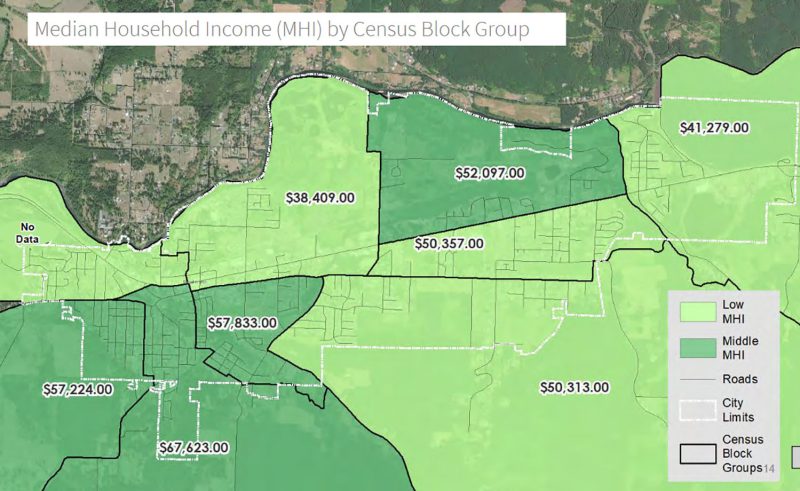The City Council and Planning Commission held a work session on Oct. 8 to hear proposed strategies intended to promote the development of housing that would reach the needs of a variety of demographics through a Housing Production Strategy (HPS).
The work session was, essentially, a review of an already-drafted HPS with time for Council to provide input, if desired. Recent state law requires cities with populations of at least 10,000 to study and plan for the housing needs of both current and future residents by using a Housing Capacity Analysis (HCA) to help create the HPS. The HPS must be completed every eight years.
Sweet Home hit the 10,000 mark at the 2020 census, making the city liable to complete the HPS. The city hired Kearns-West and Winterbrook Planning to assist in the production of the document.
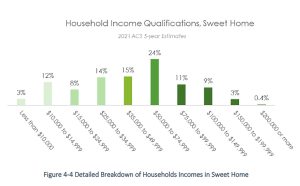 An HPS document must include specific actions the city plans to take to encourage the development of necessary housing types identified in the HCA. Actions might include perhaps changing development codes or offering financial incentives. The HCA shows the city whether it has enough land to meet projected housing needs for the next two decades. If not, the city must amend its UGB regulations.
An HPS document must include specific actions the city plans to take to encourage the development of necessary housing types identified in the HCA. Actions might include perhaps changing development codes or offering financial incentives. The HCA shows the city whether it has enough land to meet projected housing needs for the next two decades. If not, the city must amend its UGB regulations.
Earlier in the year, Kearns-West surveyed a variety of residents and community leaders regarding local housing concerns, and used their responses to help guide the development of the city’s HPS. Then they later participated in roundtable discussions.
According to the city’s 2022 Housing Needs Analysis, Sweet Home is expected to grow by 1,571 in the next 20 years, more than 25% of renters spend more than 50% of their income on rent, and the median home price increased almost 20% between 2021 and 2022 to $348,000. The report indicated the city needs 169 acres of buildable land and 632 new housing units within the next 20 years.
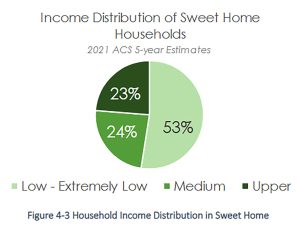 The report also noted that 53% of Sweet Home households fall into the “low or extremely low” category of income, the city is not racially diverse, there is a greater percentage of people with disabilities in Sweet Home than in Linn County or Oregon, and the potential for homelessness is a “serious concern.”
The report also noted that 53% of Sweet Home households fall into the “low or extremely low” category of income, the city is not racially diverse, there is a greater percentage of people with disabilities in Sweet Home than in Linn County or Oregon, and the potential for homelessness is a “serious concern.”
Concerns raised included the fact that older housing that falls into disrepair can result in building condemnation or displacement of residents, and national housing market trends have made new construction, rents and homeownership increasingly expensive.
Community and Economic Development Director Blair Larsen shared the city’s recent efforts to increase housing production, such as decreasing minimum lot sizes, permitting duplexes in all residential zones and reducing parking requirements. During roundtable discussions, participants reviewed strategy ideas that would address current and future housing needs.
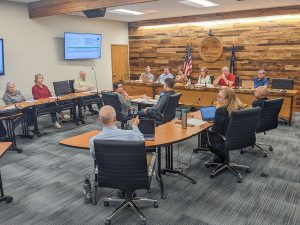 Those ideas were presented at the Oct. 8 work session. Larissa Gladding, of Winterbrook, explained that the proposed strategies are intended to reduce obstacles and create opportunities for the production of affordable housing.
Those ideas were presented at the Oct. 8 work session. Larissa Gladding, of Winterbrook, explained that the proposed strategies are intended to reduce obstacles and create opportunities for the production of affordable housing.
“Strategy A” is to publicize and clarify the city’s recent (2022) code updates that allow different middle housing and lower income housing types (duplexes, cottage clusters, Accessory Dwelling Units/ADUs, tiny homes, etc.).
“The city really took an initiative to define these housing types in ways that are really important to encourage them and to establish where they can be allowed, which is important because there is a need for middle housing and there’s also a need for some middle low-income housing,” Gladding said. “These are types of housing that people want to build now, and can be useful, but in a lot of cities, they’re just not baked into the code. So the opportunities are already existing here in ways that they’re not existing elsewhere.”
Gladding encouraged this strategy so that developers can learn about these opportunities, and she added the city should clarify the code further to make the code as understandable as possible.
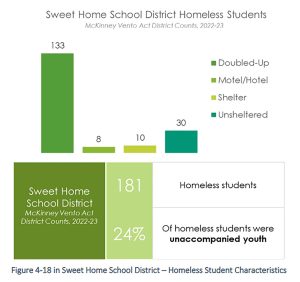 “Strategy B” calls on the city to encourage more participation in the Housing Rehabilitation Partnership Program, which provides small low interest loans for minor housing rehab projects to low income homeowners through Linn County’s Community Development Block Group funds. Larsen explained cities in the county take turns offering the loans to its residents.
“Strategy B” calls on the city to encourage more participation in the Housing Rehabilitation Partnership Program, which provides small low interest loans for minor housing rehab projects to low income homeowners through Linn County’s Community Development Block Group funds. Larsen explained cities in the county take turns offering the loans to its residents.
“Strategy C” asks to affirm the city’s commitment to fair housing by, among other things, promoting housing programs and affordable housing development, “land banking” (reserving land for affordable housing development), and partnering with a Community Land Trust.
“Strategy D,” which Gladding noted was among the more supported ideas in the roundtable discussions, involves creating prototypes or ready-to-go plans of “middle housing” (ADUs, tiny homes, cottages, etc.) that are designed according to city codes, which would streamline the permitting process. The strategy also includes encouraging local production of the homes, which would tap the area’s history with forest products and keep jobs local.
Larsen expressed interest in this idea that the city could just hand over a pack of materials that includes everything a builder or homeowner needs, such as the plans, the building official’s stamp of approval and expected costs for everything.
Another strategy supported in the roundtable discussions was “Strategy E,” which involves rezoning medium and high density residential lands. Gladding explained the city’s comprehensive plan includes areas that are planned for middle or high density housing, but the zone map does not yet allow those types. Actions within this strategy include moves that would allow single-room occupancy or dormitory-style housing in the commercial and high density zones, and more opportunities for assisted living communities or facilities.
Councilmember Lisa Gourley cautioned to guard against traffic flow issues when considering zoning.
“We need to retain the ability to grow in a healthy way as a community,” she said. “Sometimes people in larger metropolitan areas build closer to each other; in a rural setting, those houses aren’t going to sell as readily as one with a little more space between them… I think some of our rules that are in place are there to help us as we grow, that we grow in an attractive way that does bring people to our community for the right reasons.”
Councilmember Greg Mahler agreed about taking transportation issues into consideration.
Earlier, Councilmember Gourley had expressed interest in helping the elderly population who live alone in their large homes, which are often older homes that are paid off. She’d like to see opportunities for that population that would encourage them to transition to an easier living situation and, simultaneously, open up the larger homes for families.
To that point, she also noted a concern about the cost of system development charges (SDC) to build “granny flats” or accessory dwelling units, which often stop people from building those types of housing.
“Strategy F” addressed this issue, which involves modifying the SDCs. Developers are charged SDCs based on the number of units being built. A recommended action is to charge based on square footage.
Gladding provided an example scenario with the current charge schedule, in that a 3,000 square foot single family home would be charged the same fee as a 900 square foot townhome. Reducing the SDC cost would incentivize developers or homeowners to build those types of housing needed in Sweet Home, she said.
Another action to consider is exempting small ADUs and conversions of houses into duplexes from SDCs. Finally, Gladding explained another option is to receive SDC payments from developers upon occupancy, as opposed to the current requirement to pay before building. This could encourage smoother development of housing needed in Sweet Home.
Winterbrook will present a final draft of the Housing Production Strategy to City Council on Nov. 12, during which time the council can vote to adopt the report into the city’s comprehensive plan.





